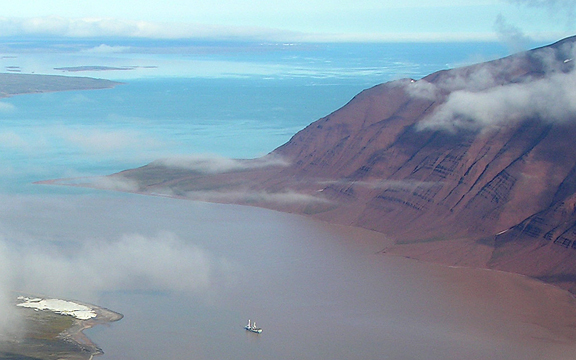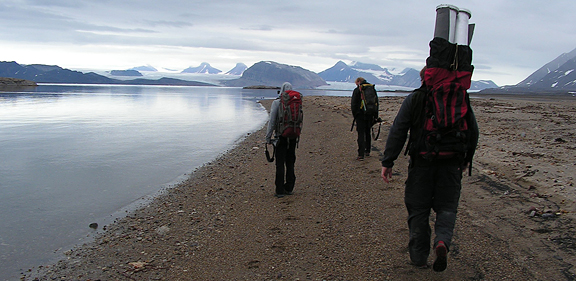AMASE blog 2009: SLIce: Searching for Signatures of Life in Ice

Juan Diego Rodriguez-Blanco: In the last days things have moved ahead in AMASE. Very busy days doing science. The Sun never sets and there are always plenty of things to do!
Part of the members of the expedition was working in Longyearbyen packing scientific equipment in the Lance -the ship where we will live during the next days- before departing. Now they are in Bockfjorden doing great research with the Athena rover, while we are working hard in NyAlesund.
Ny Alesund is a very nice place. Another old mining area transformed today into a scientific settlement, where the Norwegian Polar Institute is located and many of the houses are in fact laboratories. However, do not thing as Ny Alesund as a technological centre! It is just a few houses where scientists work studying topics related to marine biology, atmospheric physics or geology… and in fact it is the most septentrional permanently inhabited settlement of our planet. From here the sights are overwhelming: high mountains with glaciers everywhere and icebergs in a strange and silent land where sometimes you can see deers, foxes and birds.
The first thing I needed to do in Ny-Alesund was a rifle shooting training. Apart from the deers, foxes and birds there are some animals that sometimes can be very unfriendly: polar bears. And in Svalbard you are not allowed to go to the field if you don’t know how to defend yourself against them. This doesn’t mean that you will see polar bears every time that you go out, but there are incidents every year and this matter has to be taken seriously. We are sharing the same regions as them: there are specific areas that they use to transit, to live or to hunt, so the appropriate precautions have to be taken when you go to the field and the most important one is to always take a rifle with you.

Liane Benning and Jennifer Eigenbrode obtaining core samples in Friedrichbreen glacier, near Bockfjorden.
One of the strong AMASE projects that combines fieldwork and laboratory is SLIce, a really interesting research led by Jennifer Eigenbrode, a very clever young scientist who is working for NASA Goddard Space Center. SLIce is a multidisciplinary investigation of organic signatures and habitat of life in surface glacial ice. Ice can be considered as a cryogenic vault for preserving organic matter, because at so cold temperatures hydrolysis and oxidation -processes that degrade organic molecules- are very retarded, so life can survive in the presence of impurities.
Although there is life in Svalbard, there are blue-ice glacier areas where only extremophiles can thrive; they survive at very low temperatures with almost no water at all and obtaining nutrients from mineral particles and chemical substances diluted in the ice. Studying these ice cores is a very interesting task, because they can be considered as Martian analogs.

The Lance, our ship, in Bockfjorden. Bockfjorden is an amazing fjord system that stretches towards several mountain ridges of different geological ages. There are alpine summits of old granite rocks, Devonian red sandstones, three volcanic cones, hot springs and large glacier fronts that reach the sea.
If there was/is life on Mars -as we know it on Earth- the living organisms could be located in the water-ice layers under the surface. That means that by understanding how extremophiles live on Earth we can use the information to try to find out similar environments on Mars. Just a simple example: Exomars rover (ESA) will include a drilling system that will be able to take samples up to a depth of 2 metres. When these samples are characterized we will know the ambient conditions, mineralogy and chemistry of the Martian subsurface in specific areas. Depending on the nature of the drilling area we could say: ‘This is the same environment in which Earth extremophiles can survive’, information that will help really a lot in the search for life on Mars.

Ny-Alesund. You will not find any other inhabited place if you move north. This is the most septentrional settlement of the world.
The task to get the ice cores is not specially difficult. Firstly you go to a glacier to get some ice core samples and take them to the lab for analyses. There are two ways of doing that:
a) The first one is by taking five 20 Kg cylindrical containers and hiking some kilometres to a nearby glacier, do the coring and go back to the lab. In this case it is better you ask for five strong people that can take a total of 35 Kg of material per person. We did that our second day in Ny Alesund: walking a total of 12 Km with our heavy samples in our backpacks. I’m sure that people in Ny-Alesund saw us and thought something like ‘Isn’t is weird to transport all that heavy load of ice for so long when it is available everywhere?’
b) The second one is doing the same but flying by helicopter, so you don’t destroy your back and also enjoy a nice view of the landscape. We have done that yesterday. What a difference! Flying over the glaciers and the mountains at low height is something that is difficult to delete from any mind. And I am sure the readers will agree that this option is more exciting and avoids tiredness.
So during these days we are combining field trips with lab work in the Marinlab. So far we have obtained good samples in two different glaciers (Midre Lovenbreen and Friedrichbreen) and we plan to go to a third one in the next days. In all cases this is a task that has to be done carefully. All the samples must be taken avoiding any kind of biological contamination (in fact, contamination tests are done in-situ).
After drilling the cores, we take them to the lab for melting, filtration and analyses: this includes many microbiological, chemical and mineralogical tests (analyses of nutrients available, DNA, ARN, medium and high resolution microscopy imaging, XRD, aqueous solution composition analyses, etc).
Tomorrow we will finish our lab work in Ny Alesund and will travel by helicopter again to the Lance where we will continue our work and move to new and no less exciting research! Stay tuned!

A view from the landscape while flying by helicopter.

This is what you are expected to do if you don’t fly by helicopter to take the samples.

Apart from the ice cores, we take also environmental samples: running water, red and green algae, cryoconites, etc. This two pictures show red and blue algae that survive in glacier ice that was taken in Friedrichbreen glacier.

A panoramic picture of Friedrichbreen glacier, one of the three areas where ice cores are taken for the SLIce project.

Cryoconites in glacier ice. Cryoconite are a water filled cylindrical melt-holes that can be easily found on glacial ice surface. The size of these holes is variable but always in the range of centimetres. At bottom of the holes, there is dark material that absorbs solar radiation and promotes melting of the ice beneath it, forming these cylindrical holes. This cryoconites play an important role in the glacier ecosystems because many kinds of living organisms (algae, tardigrada, insects and ice worm) can found nutrients and thrive.

If you want to obtain the cleanest samples in glacier ice, you have to be appropriately dressed for the occasion! No biological contamination can occur during the sample handling, so all precautions have to be taken. From left to right: Adrienne Kish, Jennifer Eigenbrode, Juan Diego Rodriguez-Blanco (coring) and Liane Benning having fun during a short break.









